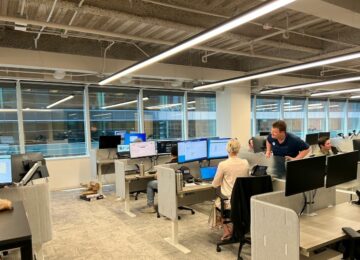
Relationships and collaboration are essential to the success of end-to-end supply chains and remain at the center of today’s supply chains. Shippers and third-party logistics companies are forming strategic partnerships and working together to improve decision-making, manage costs and increase agility.
Overall, those relationships are working. The 2024 Third-Party Logistics Study found that 95% of shipper respondents agreed that their relationships are successful and 99% of 3PL respondents agreed that their relationships are successful.
More importantly, the relationships are creating value, with 89% of shippers reporting that 3PLs have contributed to improving service and 80% saying 3PLs contribute to reducing overall logistics costs.
The study, which was released Oct. 2 at the Council of Supply Chain Management Professionals (CSCMP) EDGE conference, provides industry insights into the current state of the 3PL market, shipper-3PL relationships and the services that 3PLs provide. It also takes a deeper dive into specific industry issues, including data and analytics, technology, reverse logistics and the talent crisis.
Dr. C. John Langley, clinical professor, supply chain information systems and director of development, Center for Supply Chain Research at Smeal College of Business at The Pennsylvania State University, founded the study in 1996.
Langley, along with Tim Brindley, vice president of supply chain consulting for NTT Data, and Andy Moses, senior vice president of sales and solutions for Penske Logistics, discussed the report during a panel session at CSCMP.
The Power of Partnerships
The transportation and logistics markets have experienced significant swings in capacity, which has shifted the power dynamic in 3PL and shipper relationships.
“The elements of power and partnership need to be carefully crafted and balanced to not only meet the success objectives for each of these parties but also align with the success objectives for the overall supply chain,” Langley said. “This requires a significant commitment to the pursuit of alignment, cooperation and collaboration.”
Among respondents, 39% of shippers and 38% of 3PLs said shippers have gained leverage over the past three years compared to 30% of shippers and 31% of 3PLs that said 3PLs/4PLs have gained leverage and 31% of both shippers and 3PLs said there has been no change.
Power can become apparent during contract negotiations. Most shippers (89%) said cost savings are one of their top priorities during contract negotiations, followed by process improvement commitments (56%), and 48% want capacity commitments (48%). Additionally, 38% of shippers and 3PLs reported an increase in average contract length, and 84% of shippers and 97% of 3PLs, agreed that there’s a need for more strategic and longer-term 3PL/shipper agreements.
Shippers (92%) and 3PLs (96%) said they’re placing greater importance on collaboration and information sharing throughout the proposal response process, which 81% of shippers said may lead to using fewer suppliers of 3PL services.
The Flow of Data
Data, analytics and intelligence are optimizing supply chain performance, driving value and automating decision making. There are typically three types of data: transactional, historical and forecast, and the amount of data flowing between shippers and 3PLs continues to grow.
The most common data shared with external supply chain partners relates to transportation and logistics performance, inventory levels, supplier performance and order history.
Shippers see the most significant value in supply planning (65%), demand forecasting (61%) and inventory management (61%). Among 3PLs, the greatest value was in route optimization (61%), inventory management (55%) and freight invoicing and billing (54%).
Despite the importance of data sharing, the process can have its challenges, including integration, data standard issues and costs. Data quality is a top concern, and although they don’t often own the data, 3PLs may be on the receiving end of poor data quality.
Both parties said they take several steps to protect data quality. 3PLs rely on end users and IT staff to check and resolve data quality issues more often than shippers and also leverage data monitoring tools that automatically detect and notify stakeholders of data quality issues.
3PLs ranked themselves somewhat higher in their maturity at driving operational value out of real-time supply chain data, with 60% reporting that they are using dashboards or other real-time data visualization tools compared to 50% of shippers.
The Importance of Technology
3PLs are making substantial investments in technology that can generate value for shippers, improve decision-making, cut costs and serve as a competitive differentiator.
Nearly all respondents, 87% of shippers and 94% of 3PLs, agree that emerging technology adoption is critical to their company’s future growth and success. Additionally, 83% of shippers and 79% of 3PLs reported they’re already working together or plan to collaborate on technology.
“We get a lot of very direct feedback from customers on specific problems they are trying to solve,” Moses said.
The top emerging technologies shippers have invested or plan to invest in include advanced predictive analytics, supply chain control towers, and RFID and other advanced sensors.
3PLs appear to be more confident than shippers in their technology-related abilities and are adopting technology at a slightly higher rate. Moses said 3PLs are often able to explain to shippers what they can do. “It is not a given that they are aware of what is possible. Sometimes, we’re in that mode of helping them understand the possibilities,” he said.
Despite the benefits of and emphasis on technology, barriers to adoption remain. The top challenge is the lack of a clear business case (54% of shippers and 56% of 3PLs). Half of shippers and 46% of 3PLs noted a lack of capital, and 43% of shippers and 3PLs cited a lack of adequate talent.
Continuing the Conversation
The study team continued to follow trends in reverse logistics and the labor market that were covered in depth last year.
Demand for reverse logistics and returns volume is growing, and reverse logistics remains integral to supply chain management. The study grouped participants into two distinct shipper clusters—customer-focused shippers and business-exclusive shippers—and the two groups report differing experiences.
Among consumer-focused brands, 71% reported that expectations surrounding returns are increasing, up from 65% last year. However, just 44% of business-focused shippers believe expectations are on the rise, down from 60% in the previous study.
Plus, 82% of consumer-focused shippers ranked the returns process as very or extremely important to customer loyalty (up from 75% last year) compared to just 27% of business-exclusive shippers rated it at a similar level (down from 43% last year).
Labor challenges continue to impact the supply chain, and 78% of shippers and 40% of 3PLs said labor challenges have impacted their service level agreements. There have been some improvements over last year, but many organizations still struggle.
The hardest positions to fill and retain are hourly workers, such as pickers and packers, and licensed hourly workers, such as truck drivers and equipment operators.
Shippers and 3PLs have deployed several strategies to encourage employees to stay, including flexible scheduling, remote work and development opportunities. They are also turning to automation to help augment the existing workforce, increase efficiency, and work safer and more attractive to employees.
Contemporary Issues
As part of the 2024 28th Annual Third-Party Logistics Study, the study team also evaluated critical issues shippers and 3PLs face in today’s supply chains that’ll shape the future. This year’s study focused on the balance between efficiency and resiliency, the continued growth of the cold chain and the changing landscape of online sales.
Download the Study
The full study, which is sponsored by NTT Data and Penske Logistics, is available free of charge at www.3PLStudy.com.
By “Move Ahead” Staff
- SEO Powered Content & PR Distribution. Get Amplified Today.
- PlatoData.Network Vertical Generative Ai. Empower Yourself. Access Here.
- PlatoAiStream. Web3 Intelligence. Knowledge Amplified. Access Here.
- PlatoESG. Carbon, CleanTech, Energy, Environment, Solar, Waste Management. Access Here.
- PlatoHealth. Biotech and Clinical Trials Intelligence. Access Here.
- Source: https://www.gopenske.com/blog/the-2024-third-party-logistics-study-shippers-3pls-draw-on-the-power-of-partnerships
- :has
- :is
- :not
- $UP
- 1996
- 2024
- 28th
- 3PL
- 95%
- a
- abilities
- Able
- Additionally
- Adopting
- Adoption
- advanced
- agreed
- agreements
- align
- All
- along
- already
- also
- Although
- among
- amount
- an
- analytics
- and
- annual
- apparent
- appear
- ARE
- AS
- At
- attractive
- automatically
- automating
- Automation
- available
- average
- aware
- Balance
- balanced
- barriers
- BE
- become
- been
- believe
- benefits
- between
- billing
- both
- brands
- business
- but
- by
- CAN
- Capacity
- capital
- carefully
- case
- Center
- chain
- chains
- challenge
- challenges
- change
- changing
- charge
- check
- cited
- clear
- Clinical
- cold
- collaborate
- collaboration
- College
- commitment
- commitments
- Common
- Companies
- company
- compared
- competitive
- Concern
- Conference
- confident
- consulting
- continue
- continued
- continues
- contract
- contribute
- contributed
- control
- cooperation
- Cost
- cost savings
- Costs
- Council
- covered
- crafted
- Creating
- Creating Value
- crisis
- critical
- Current
- Current state
- customer
- Customer Loyalty
- Customers
- Cut
- cut costs
- dashboards
- data
- data monitoring
- data quality
- data sharing
- data visualization
- decision
- Decision Making
- deeper
- Demand
- Demand forecasting
- deployed
- depth
- detect
- Development
- differentiator
- differing
- direct
- Director
- discussed
- distinct
- dive
- do
- Dont
- down
- draw
- drivers
- driving
- during
- dynamic
- each
- Edge
- efficiency
- elements
- emerging
- emerging technologies
- Emerging Technology
- emphasis
- employees
- encourage
- end
- end-to-end
- equipment
- essential
- evaluated
- existing
- expectations
- experienced
- Experiences
- Explain
- external
- extremely
- Face
- feedback
- fewer
- fill
- flexible
- flow
- Flowing
- focused
- follow
- followed
- For
- Forecast
- found
- Founded
- Free
- freight
- from
- full
- future
- future growth
- gained
- generate
- get
- given
- greater
- greatest
- Group’s
- Grow
- Growing
- Growth
- Half
- Have
- he
- help
- helping
- higher
- historical
- history
- However
- http
- HTTPS
- Impact
- impacted
- importance
- important
- improve
- improvement
- improvements
- improving
- in
- include
- Including
- Increase
- increasing
- industry
- Industry Insights
- information
- Information Systems
- insights
- integral
- integration
- Intelligence
- into
- inventory
- Inventory Management
- Invest
- invested
- Investments
- invoicing
- issues
- IT
- ITS
- John
- jpg
- just
- labor
- labor market
- Lack
- landscape
- Last
- Last Year
- lead
- Length
- Level
- levels
- Leverage
- Licensed
- ll
- logistics
- Lot
- Loyalty
- Making
- manage
- management
- many
- Market
- Markets
- maturity
- May..
- Meet
- Mode
- monitoring
- more
- most
- Need
- negotiations
- no
- noted
- NTT
- objectives
- Oct
- of
- often
- on
- ONE
- online
- online sales
- only
- operational
- operators
- opportunities
- optimization
- optimizing
- or
- order
- organizations
- Other
- out
- over
- overall
- own
- panel
- part
- participants
- parties
- partners
- Partnership
- partnerships
- past
- Pennsylvania
- performance
- placing
- plan
- planning
- plato
- Plato Data Intelligence
- PlatoData
- poor
- positions
- possibilities
- possible
- power
- predictive
- Predictive Analytics
- president
- previous
- problems
- process
- professionals
- Professor
- proposal
- protect
- provide
- provides
- pursuit
- quality
- ranked
- Rate
- rated
- RE
- real-time
- real-time data
- receiving
- reducing
- relates
- Relationships
- released
- rely
- remain
- remains
- remote
- remote work
- report
- Reported
- Reporting
- requires
- research
- respondents
- response
- retain
- returns
- reverse
- Rise
- Route
- s
- safer
- Said
- sales
- Savings
- saying
- scheduling
- see
- senior
- sensors
- serve
- service
- Services
- session
- several
- Shape
- shared
- sharing
- shifted
- significant
- similar
- Solutions
- SOLVE
- some
- somewhat
- specific
- Sponsored
- Staff
- stakeholders
- standard
- State
- stay
- Steps
- Still
- Strategic
- Strategic Partnerships
- strategies
- Struggle
- Study
- substantial
- success
- successful
- such
- supplier
- suppliers
- supply
- supply chain
- supply chain management
- Supply chains
- Surrounding
- Swings
- Systems
- Take
- takes
- Talent
- team
- Technologies
- Technology
- than
- that
- The
- The Future
- their
- Them
- themselves
- There.
- These
- they
- third-party
- this
- those
- three
- throughout
- Tim
- to
- today’s
- together
- tools
- top
- transactional
- transportation
- Trends
- truck
- trying
- Turning
- two
- types
- typically
- understand
- university
- users
- using
- value
- very
- vice
- Vice President
- visualization
- volume
- want
- was
- we
- were
- What
- What is
- which
- with
- Work
- workers
- Workforce
- working
- year
- years
- zephyrnet







